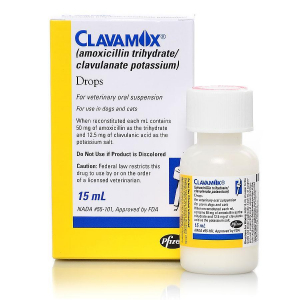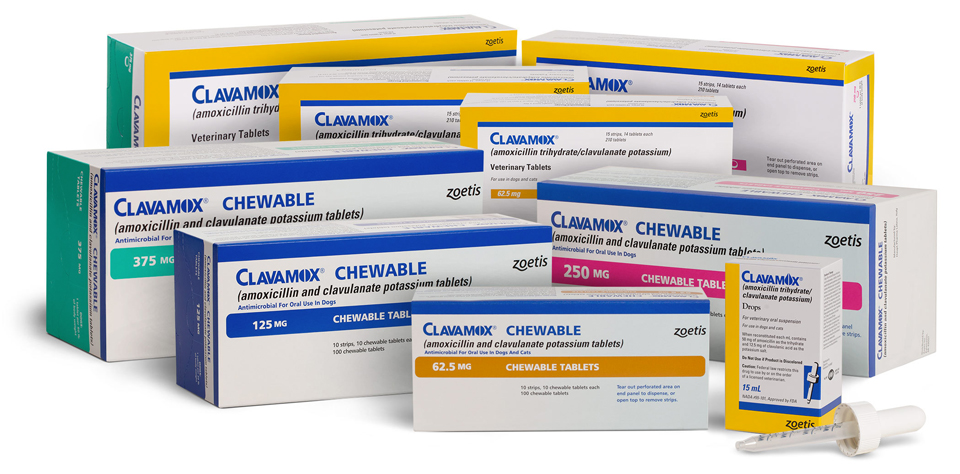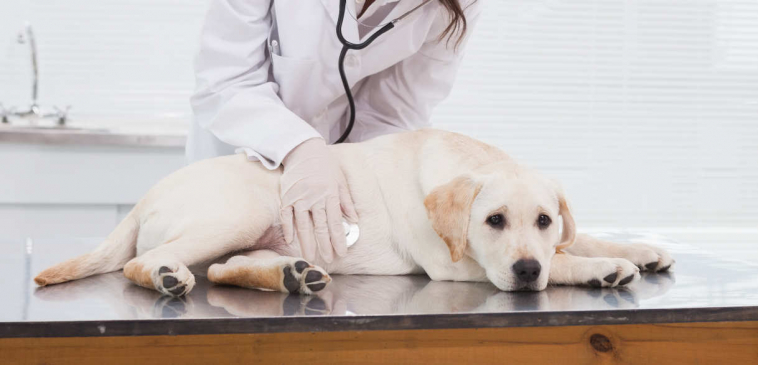Maybe their skin began to crust over. Perhaps they started to lose their hair. You might have even noticed some unattractive lesions peppering their body. Chances are, it was at that point that you decided to buckle down and bring them to the vet, and the diagnosis came back: a skin infection.
Frustrating . . . but treatable.
What is Clavamox for dogs?

The prescription? Clavamox. You nod sagely to your vet, accept his diagnosis and advice, and strut out the door with the prescription in hand.
If you’re reading this, chances are it’s because you want to know more about the drug before giving it to your pet. That’s why this article is going to act as a complete, comprehensive guide to the medication so that you know what it is, how it’s used, and what to look for once you start treatment for your dog.
Even if you don’t have it in hand yet though, we’ll walk you through the process of getting it from your vet to ensure that you can use it safely and reliably.
So, let’s get started.
Related: Best Probiotic for Dogs – Top 5 Picks Reviewed
Clavamox is a drug that has been formulated and approved by the FDA specifically for use on our beloved pets. To put it in its simplest terms, Clavamox is an anti-bacterial drug that is used to fight infections that fester in open wounds.
An infection-fighting drug

It’s derived from a form of penicillin called Amoxicillin, which targets bacteria, fights them off, and eventually kills them to clean the wound and rid it of infection.
It’s even used in people in a variety of drugs, so all else being equal, it’s deemed quite safe for consumption by canines.
Where Clavamox differs from those human drugs is that it includes another compound: Clavulanic acid. You might have heard about bacteria that are becoming resistant to penicillin?
An added super-bug annihilator
Overuse of the drug has created bacteria that produce what is known as beta-lactamase that works by shutting down the effects of amoxicillin, which allows the bacteria to continue to progress and thrive. Clavulanic acid inhibits this response, allowing the drug to have its intended effect. Pretty handy, right?
Well, with these two compounds working side by side, Clavamox has proven to be extremely effective at reducing inflammation, treating infections (of course), and killing bacteria. This means that within just a few days, your dog should experience a rapid recovery from whatever ails them.
Forms of administering Clavamox

With all that information in hand then, how do you go about actually giving the medication to your suffering pet? Thankfully, there are a wide variety of options to choose from to ensure that medicating your pet is a quick and stress-free procedure.
Chewables and pills
You’ll most likely be given chewable tablets, which are relatively easy to get your dog to consume. However, some vets prefer to hand out standard pills that need to be swallowed, and this is slightly more complicated for most owners since dogs don’t often enjoy the process.
Liquid
One interesting thing of note is that this particular drug also comes in drop form. These usually come in a small bottle and need to be refrigerated, not frozen, to maintain it’s freshness.
All these forms of medication need to be given orally and must be provided with food to make the drug more effective and reduce potential nausea in your pet.
What is Clavamox used for in dogs?

Well, to put it quite simply, in many cases you won’t have much of a choice. Bacteria that is allowed to fester and spread can create painful infections in cuts and sores that can result in catastrophic side effects.
In the short term, it might not be that bad, but eventually, a lack of treatment can result in extreme effects that can even be fatal.
Excellent for minor ailments
In some more minor cases like a bladder infection, untreated bacteria can result in UTIs that can cause bleeding, painful trips to the bathroom, and more.
Improperly treated diseases can also cause the bacteria to persist, which cause symptoms and conditions to reoccur on a frequent basis. This will make your dog miserable and can quickly make their care bills lavishly expensive.
Clavamox is not a cure-all drug
However, there is one catch. While Clavamox is a great general purpose anti-bacterial agent, it doesn’t work on every infection under the sun. If your dog is suffering from a viral infection (like CPV, or canine parvovirus which is infectious and results in digestive issues) or a fungal infection (like blastomycosis), then Clavamox won’t work at all.
That’s why it’s important to always see or consult with your vet as new symptoms begin to develop, rather than administering any pills you might have left from a previous infection.
Where can I buy Clavamox for my dog?

Unfortunately for your ailing dog, Clavamox has to be prescribed by a licensed veterinarian, which means you’re going to have to jump through some hoops to get it.
Thankfully, however, as opposed to more general-purpose drugs like NSAIDs, your dog is likely to get the prescription he or she needs if they can benefit from it, without the vet requiring the use of a judgment call to gauge severity.
A proper diagnosis is vital
It’s not as simple as walking into your vet’s office and exclaiming that you’ll need some Clavamox for your dog, though. Because the drug only works on specific infections, your vet has to properly assess and diagnose the ailment of your dog by taking what is known as a “bacterial culture.”
This is done by swabbing the affected area (for example, the gums) with cotton and then examined in a laboratory to test for the presence and type of bacteria plaguing your dog. This means the process between the initial visit with your vet and the final diagnosis and prescription might take a while.
To ease your dog through the process then, it’s a good idea not to delay visiting your vet and seeing them as soon as symptoms begin to surface.
What should I tell my vet?

Because of its specialized use in systematically targeting and eliminating bacteria, Clavamox is considered a significantly safe drug for use until the treatment is completed.
Still, upon your first visit it couldn’t hurt to discuss exactly what symptoms are present and the frequency of their occurrence, since this could expedite the diagnosis by limiting the scope of bacteria that they look for in their culture and sensitivity test.
Is your dog pregnant or allergic to penicillin?
Still, no drug is perfectly safe for all pets. If your dog is pregnant, your vet may reconsider giving you a prescription. Some dogs can unfortunately even be allergic to penicillin, which would cause some undesirable effects if you neglect to mention this before leaving.
Remember to mention liver or kidney issues
Finally, liver or kidney disease history should also be reported. This is because the drug has, on rare occasions, been linked to liver injuries. Already existing conditions could be made worse when Clavamox is taken, so it’s better to be safe than sorry and merely report the issue ahead of time.
Clavamox dosage for dogs

As always, be sure to discuss this with your veterinarian before you give your dog your first dose, but the general guidelines for use are as follows.
Typical dosage amounts
Dogs are typically required to take 6.25 mg of the drug per pound of body weight, and this has to be done twice per day. Because of this precise ratio, the drug is offered in a variety of sizes. Pills are available in the following strengths:
- 62.5 mg for ten-pound dogs
- 125 mg for twenty-pound dogs
- 250 mg for forty-pound dogs
- 375 mg for sixty-pound dogs
This variety means that all pets can take some combination of these strengths to get their required dose of antibiotics.
For dogs in between these ranges, it’s important to discuss with your veterinarian how to accurately dose your pet. Because the pills aren’t scored, it is not recommended to split them apart for smaller pets.
For how long do I give my dog Clavamox?
The length of use should be reasonably straight-forward since you’ll probably be advised to use the drug until your prescription runs out. That means you won’t have to track days or terms of use.
In general cases, however, most infections will be cleared up within a week, and you’ll want to keep using the meds for a few days after symptoms disappear to prevent lingering bacteria from making a resurgence.
More extreme cases of pyoderma that results in lesions can last for almost a month, however, so don’t be surprised if you get a fairly weighty container of pills.
A reasonably quick recovery can be expected
The most important thing to keep a note of when using Clavamox is that symptoms should have noticeably improved in just a few days. If your dog doesn’t seem to be responding to the treatment, it’s strongly advised that you see your vet for a follow-up since it’s possible they misdiagnosed the bacteria.
Waiting for too long could cause the symptoms to worsen, which is something that nobody wants.
Caution: Avoid overdosing
It’s essential that you follow the dosage to the letter because giving too much can severely damage your dog’s kidneys at worst, but even if you avoid this worst-case scenario, it can still cause digestive distress such as vomiting. More of the drug won’t get rid of the infection any quicker, so get the dosage and scheduling down, and stick to it.
Clavamox side effects

Most drugs these days have side effects, but those for Clavamox are a bit milder than most.
Allergic to penicillin
If this is the first time you’re giving your dog a drug that has derived from penicillin, then allergic reactions are probably the worst you can expect to see and should be reason enough to immediately stop using the drug and see your vet for alternative treatment.
Gastrointestinal issues
The other major thing to watch for is recurring, consistent diarrhea. It’s normal when giving your pet the drug for the first time for it to happen, but his or her digestive system should quickly adjust and go back to normal. In the meantime, make sure they have a lot of fresh water to prevent dehydration.
More susceptible to secondary infections
The other side effects might be counter-intuitive and require an explanation. As your dog is taking Clavamox, he or she will be more, not less, likely to contract additional infections. This is rare, but relatively standard if it occurs and shouldn’t be a cause for alarm.
This is because the body has a weakened immune system as it fights off the source of the original infections and is, therefore, more likely to pick up something else. That doesn’t mean it will sprout out of nowhere though.
They still need to be in contact with something to transmit the infection, so while they’re undergoing treatment be sure not to let them wander too far off of home turf. Even if it occurs though, you can continue using Clavamox. You just should let your vet know so that he can prescribe something else if need be.
Final say on treating dogs with Clavamox

When you get into the science behind it, Clavamox is a tricky little substance that works to destroy microscopic bacteria and bring your dog back to pristine health. Thankfully, what you need to know is much simpler. In this comprehensive guide we’ve covered everything from :
- what it is
- how it works
- where and how to give it
- and things you should be looking out for to keep your dog safe and sound.
It’s a lot of information, but you can always refer back to this article if ever you have a question and your vet isn’t available. The key takeaway is that Clavamox is a relatively safe, helpful drug that is used for a variety of bacterial infections.
That means if you have any reason at all to believe that your pet is suffering from something that might be treated by its use, then you should not hesitate to call your vet and ask for their opinion and advice. If you’re here though, chances are you have the tablets in hand and are ready to dose your dog. If that’s the case, good luck! Use it with confidence, and hope they feel better in no time.

